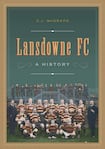
Moss Keane once gloriously described rugby as “like a pornographic movie – very frustrating for those watching, and only enjoyable for those participating”. If it’s sometimes hard to understand the game’s bewildering array of “laws”, the après-match camaraderie among team-mates and between teams who have just spent 80 minutes trying to maim each other is a huge part of the sport’s enduring charm. The sense of belonging, of identity, of being all in this together fostered by clubs such as Lansdowne is alluring for many, particularly in an increasingly fragmented postmodern society, which perhaps explains why this popular Irish sporting institution has survived so long.
Full disclosure: For many years I played with Lansdowne, mostly in the lower orders. We took it seriously but not too seriously; in one of my last games, our captain addressed us wearing a clown’s nose. Any official club history will focus on its teams’ achievements, and Lansdowne is proud of its myriad trophies (including three All Ireland Leagues and 28 Leinster Senior Cups) and the 117 members capped as internationals. McGrath’s eye for the intriguing detail makes this faithful and occasionally quirky chronicle highly readable. Before Westlife played there, you could graze your flock on the Lansdowne turf for a penny per sheep per night, an early example of the club’s consistently savvy financial management.
Frustration at the IRFU’s glacial rate of response to the need for change and requests for funding is another theme. The “blazers” resisted the introduction of Sunday matches, and dragged their heels over opposing apartheid, while also warning Irish internationals travelling to Cardiff (including Lansdowne’s Con Murphy) to bring their own soap and towel. Murphy is a club legend, as are the Dawsons and the Coffeys; others include celebrated internationals such as Ernie Crawford and Eugene Davy. A grainy photograph shows Crawford, cigarette clenched in his teeth, giving half-time advice to Davy; both men stood in the 1932 general election, another nugget unearthed by McGrath.
The professionalisation of rugby may be the greatest existential threat Lansdowne faces, but a thriving mixed underage section hopefully will help the club survive another 150 years. Some traditions die hard. During a Christmas visit, Santa (uncannily resembling an infamous backrow) doled out gifts to delighted “minis” – provided they promised never to join Wanderers.









